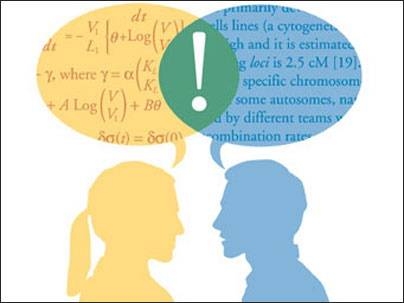Biologists, computer scientists and engineers speak different languages: Mention "vector" to a molecular biologist and a plasmid (a circular piece of bacterial DNA used in gene cloning) comes to mind. Say "vector" to an engineer, and she thinks of a mathematical concept. Similarly with "expression": To a biologist, it means protein production from a gene; to an engineer, it's an equation.
This communications divide is becoming more of a problem now that research so often requires collaboration across disciplines. One-third of the engineers at MIT now work on biological problems, according to Graham C. Walker, MIT biology professor. Yet it can be challenging for biology and engineering students to understand each other.
The divide, deeper than mere semantics, can touch on basic cultural differences, he says. "Even among top-level scientists, our fundamental ways of conducting inquiry differ, depending on our interests and training."
Teaching introductory biology to MIT undergraduates, Walker experiences the disciplinary disconnect firsthand. "It's a constant challenge," he says, "to find ways to make biology comprehensible and relevant to students who think like engineers."
As a Howard Hughes Medical Institute (HHMI) professor--one of 20 research scientists nationwide who received $1 million each from HHMI to find innovative ways to stimulate undergraduates' interest in science--Walker is ever on the lookout for solutions to this problem. Last spring he invited Mary E. Lidstrom, a fellow HHMI professor, to MIT to discuss how she grapples with it at the University of Washington.
Lidstrom, who conducts an elective biology class for engineers, has found that biologists are motivated by the "what," while engineers are motivated by the "how." She told a room packed with MIT students and faculty that "engineering students tend to view biology as magic because they don't see us using differential equations. And often they don't even necessarily want to understand the 'what' of biology--they just want to use it.
"So we actually teach biology to engineers using a function-based approach, with the idea of nature as the designer and evolution as the design tool," Lidstrom says. "That's real engineering. And that's the way we feel biology should be taught."
To help her engineering students feel comfortable in this strange new territory, she says, "We talk about the functions of life, about information transfer, about adaptability. Engineers understand systems, and ecology is the perfect example of a system."
But while Lidstrom's approach may be useful for engineering students, says Julia Khodor, a graduate student who helps teach Walker's introductory biology course at MIT, it may be limited to engineering students. "Because our lectures need to reach all students, regardless of background," she says, "they are likely to remain mostly in the language of biology."
Lidstrom suggests another option--in effect, double majors. "The new research workforce will always need people firmly based in the core disciplines of biology and engineering," she says, "but it also needs translators who have the understanding and the tools to communicate about the other field."
Douglas A. Lauffenburger, a biological engineer who helped develop MIT's new major in that field, agrees. "The world of science keeps expanding," he says. "For a synthesis to be effective, we have to educate a third kind of person--a 'bilingual' one."
Reprinted with permission. A longer version of this article first appeared in the Dec. 2005 issue of the Howard Hughes Medical Institute Bulletin.
A version of this article appeared in MIT Tech Talk on November 22, 2006 (download PDF).






